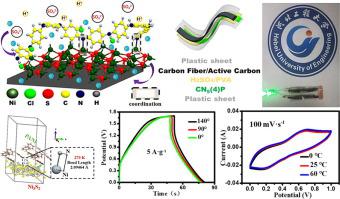Journal of Colloid and Interface Science ( IF 9.4 ) Pub Date : 2020-05-18 , DOI: 10.1016/j.jcis.2020.05.046 Lei Wang 1 , Maolin Bo 2 , Zengcai Guo 1 , Huanhuan Li 1 , Zhongkai Huang 3 , Hongwei Che 1 , Zhihang Feng 1 , Yanming Wang 1 , Jingbo Mu 4

|
Highly flexible supercapacitors (SCs) have attracted significant attention in modern electronics. However, it has been found that flexible, metal sulfide-based electrodes usually suffer from corrosion, instability and low conductivity, which significantly limits their large scale application. Herein, we report on an electrode comprised of highly stable, free-standing carbon fiber/trinickel disulphide covered with polyaniline (CF/Ni3S2@PANI). This electrode was prepared and then employed in a high-performance of flexible asymmetric SCs (FASC). The coating layer of polyaniline served as both a protector and conducting shell for the Ni3S2 due to the nature of the highly stable N-Ni bonds that formed between the polyaniline and Ni3S2. In addition, the lightweight carbon fiber support served as both a current collector and flexible support. The prepared CF/Ni3S2@PANI electrode exhibited a significantly enhanced specific capacity (715.3 F·g−1 at 1 A·g−1) compared with the carbon fiber/Ni3S2 electrode (318 F·g−1 at 1 A·g−1). More importantly, the assembled FASC device delivered an impressive energy density of 35.7 Wh·kg−1 at a power density of 850 W·kg−1. The FASC device benefited from the interconnected flexible microstructure and the stable bond bridges, so that it could be bent into various angles without noticeably impairing its performance. This effective protective strategy may further inspire the design and manufacture of metallic oxide or sulfide electrode with ultrahigh-stability interbond bridges for high-performance flexible supercapacitors.
中文翻译:

基于高性能柔性非对称超级电容器的碳纤维构建超稳定的三硫化二镍(Ni3S2)/聚苯胺(PANI)电极。
高度灵活的超级电容器(SC)在现代电子领域引起了极大的关注。然而,已经发现,柔性的,基于金属硫化物的电极通常遭受腐蚀,不稳定性和低电导率的困扰,这极大地限制了它们的大规模应用。在此,我们报道了一种电极,该电极由高度稳定的自立式碳纤维/二硫化三镍三硫化物组成,并覆盖有聚苯胺(CF / Ni 3 S 2 @PANI)。制备该电极,然后将其用于高性能的柔性不对称SC(FASC)。由于高度稳定的N的性质,聚苯胺涂层既充当Ni 3 S 2的保护层又充当导电壳-在聚苯胺和Ni 3 S 2之间形成的Ni键。另外,轻质碳纤维支撑件既可以用作集电器,又可以用作柔性支撑件。与碳纤维/ Ni 3 S 2电极(318 F·g -1)相比,所制备的CF / Ni 3 S 2 @PANI电极的比容量(715.3 F·g -1在1 A·g -1)显着提高。在1 A·g -1)。更重要的是,组装后的FASC装置在850 W·kg -1的功率密度下提供了令人印象深刻的35.7 Wh·kg -1的能量密度。。FASC装置得益于互连的柔性微结构和稳定的键桥,因此可以将其弯曲成各种角度而不会显着损害其性能。这种有效的保护策略可以进一步激发设计和制造具有超高稳定性键合桥的金属氧化物或硫化物电极,以用于高性能柔性超级电容器。











































 京公网安备 11010802027423号
京公网安备 11010802027423号